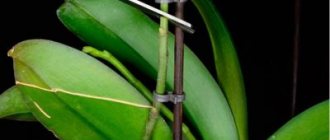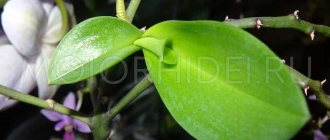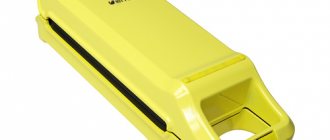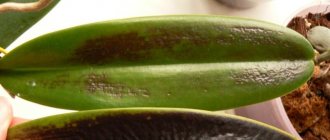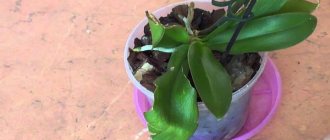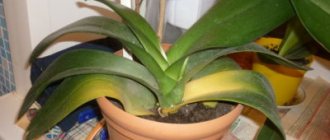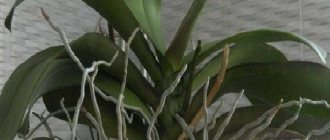For what reasons do orchids have no babies?
If the orchid was grown incorrectly or was poorly cared for, then the cuttings may not appear at all or will turn out to be underdeveloped, with no roots. The nutrition and maintenance of the mother bush is reflected in the growth of shoots and their number.
Reasons why there are no layers:
- Lack of lighting affects the development of children. The length of the day should be 10-12 hours. The light needs to be diffused; the plant should not be in direct sunlight. In winter, when the days are short, additional lighting is installed.
- Lack of fertilizers, wrong composition, or excess fertilizing. Without fertilizers, the orchid will not be able to supply itself and its shoots with nutritional components, but overfeeding will also have a bad effect on the children.
- Lack of moisture will cause even the rudiments of layering to dry out. If the water does not arrive on time, the mother plant will dry out, then we are not talking about any children, the orchid itself will have to be saved.
Stress and unfavorable conditions also force the orchid to form a new plant. Especially when this threatens her life, the flower insures itself by leaving offspring for further reproduction. Such layerings do not develop roots for a long time and take root with difficulty.
Factors for the appearance of shoots in an orchid:
- dying off of the growing point;
- trunk damage;
- drought;
- development of a peduncle from the center of the rosette.
Rooting errors
The most common mistake novice orchid growers make is tearing off a wilting leaf. Under no circumstances should leaf blades that have begun to die be forcibly removed. This is explained very simply. A weakened plant cannot use its root system to obtain nutrition, so in order to survive, the orchid begins to draw supplies of nutrients from the lower leaves. By removing them, you significantly reduce the plant's chances of survival.
The next common mistake is the lack of processing of slices. Wound surfaces that have not been disinfected can become a source of infection with various putrefactive bacteria. If this happens, successful rooting is out of the question.
Also, many gardeners place the orchid in an insufficiently lit place during rooting. In this case, due to insufficient photosynthesis, the plant begins to experience oxygen starvation. Its result is rapidly increasing cell death and complete death of the entire orchid.
Why the lack of a root system is a problem
The appearance of a phalaenopsis baby causes joy. Who doesn't want to get another beautiful plant in the house. But if the shoot does not acquire a root system or the roots are too weak, the young growth will not survive the transplant and will die.
To separate and transplant the cuttings into a new container, you first need to grow roots. If this is not done, the young shoot will take all the nutrition from the mother flower and flower stalks may not appear on it. Without good nutrition, the orchid itself will begin to get sick often, and its immunity will weaken.
What measures need to be taken
The new growth needs to be observed. If roots do not appear on it within 5-6 months, then it will be necessary to help grow the roots. You can separate the shoot from the mother bush and transplant it into water, a greenhouse, or grow it on bark. The task is not easy, but good results are obtained.
You can grow a rhizome in different ways - artificial or natural. They raise the baby in a piece of polystyrene foam or create greenhouse conditions for the flower by planting the young in cups with a substrate under the film.
Is it possible to extend the time in bloom?
The surest way to extend the flowering time of an Orchid is to properly care for it. Any deviation from the norm can lead to withering and falling off of the buds or drying out of the entire peduncle.
Factors that allow you to control the flowering process:
- Different air temperatures during the day and night.
- Duration of daylight hours, i.e. increasing it if necessary.
You can control the flowering process from the moment the buds form until the last flower fully blooms.
In conclusion, I would like to note that all plants need special care and if the grower is not ready to create favorable conditions for each ward, you should not expect outstanding results. Regarding Orchids - only patience and attentiveness will allow you to grow a strong and healthy flower.
If you find an error, please select a piece of text and press Ctrl+Enter.
- Author: Maria Sukhorukikh
Rate this article:
- 5
- 4
- 3
- 2
- 1
(0 votes, average: 0 out of 5)
Share with your friends!
Is it necessary to separate from the mother?
You can leave the cuttings on the mother plant until the roots grow. Usually the orchid itself takes care of the sprout. After 60-90 days, the rudiments of roots appear.
It will take six months for the formation of a full-fledged shoot on the orchid peduncle. By this time, the cuttings will have roots and the necessary maturity for transplanting into a separate container. The offspring is planted when the roots are at least 5-6 cm and there are 4-5 full leaves. In this case, layering no longer allows the orchid to develop normally, taking away the flower’s strength, so in order to save the plant, the baby is separated.
Important!
If a young plant has only one root, it may be damaged during transplantation and there will be nothing to replace it with. Therefore, there must be at least 2 developed roots.
Do I need to expand?
This should be decided exclusively by the florist. You need to think about this question about four months after the shoot appears on an adult orchid. If after this period of time the baby is still left without roots, you should think about helping the baby and how to root it correctly.
You can take a risk and plant a shoot without an extended root system, but you can be 80 percent sure that this will not give a positive result. Therefore, before the procedure of separation from an adult plant, we recommend that you still take care of the presence of roots on the shoot.
Read more about how to plant a shoot on an orchid stem and how to care for the baby in this material.
Another more acceptable option for any gardener would be to grow roots on an already separated baby, how to do this? There are several options here. We will describe which ones exactly in the article below. But in any case, we strongly recommend not to hope that the root system will appear on the baby by itself.
To grow roots in a young orchid shoot, it is not necessary to separate it from the adult plant. To begin with, you can try to get rhizomes to appear on the peduncle. If this does not help, move on to more radical measures. We will talk about all the methods in more detail below in the article.
Is it possible to separate the baby from the flower if it is blooming?
When the plant blooms, it is not advisable to separate the shoots. Having disturbed a flower, it is not known how it will react to such actions. But there are hybrids that bloom endlessly. A flowering plant grows children that develop, and the peduncle, shedding some flowers, immediately forms new buds.
If the cutting is already more than 4-5 months old, it has formed roots 6-7 cm long, has 4 leaves, then it can be disconnected from the mother bush even during the budding period. You should also pay attention to the condition of the adult flower; if it is sick, it is better not to disturb it and wait until it recovers.
You don’t have to separate the shoot from the mother bush; it won’t “eat” the parent. The layering root system is already capable of feeding on the substrate on its own. We must not forget to feed and water the orchid. It is advisable to transplant the overgrown plant into a larger pot so that everyone has enough space and soil.
What to do if the arrow does not release?
It is not uncommon for an Orchid to categorically refuse to bloom. It can turn green for years, but not produce flower stalks, and this undoubtedly upsets the owners of the capricious plant.
- Lack of light, especially in cold months.
- Incorrect watering scheme: too much or not enough.
- Temperature violation.
- Dry air.
- Lack of nutrients.
To force an Orchid to release a flower arrow, the two most reliable methods are usually used:
- Reduce the amount of liquid when watering.
- They create a stressful situation by lowering the air temperature.
As a rule, these methods work, the plant is “scared” and strives to reproduce, and the gardener enjoys amazing flowers.
We invite you to watch a useful video about what to do to make an orchid bloom:
How to separate a baby
If the main plant is not sick, and the baby is at least 6 months old and has its own roots, then you can disconnect it. First you need to prepare a pot and planting mixture for the seedling. You can buy it in a store, or you can make it yourself. You will need pine bark, sphagnum moss, peat, and fern roots. Additional components: coal, walnut peel, coconut fibers.
Separating tools.
- knife, scissors, pruning shears - only sharp ones;
- cinnamon, crushed coal;
- disinfectant;
- container, substrate.
Peduncle cutting
Layers can grow on a flower shoot, from the roots of the main plant, or in the axil of a leaf. How to cut off a baby depends on its location. The growing shoot on the flower branch is cut off along with part of this stem. On each side, cut 3 cm from the place of attachment of the layering. Using pruning shears, carefully cut off part of the peduncle with the baby, dry the sections, sprinkle with charcoal or cinnamon.
The cuttings are cut off when they become really heavy for the peduncle. It has at least two long roots and 3-4 leaves.
Important!
All instruments must be disinfected.
Branch at the root
It is necessary to carefully examine the adult plant, find where the layer is attached at the root, and find all its roots. Carefully remove the roots from the substrate so that during removal the roots are not damaged or torn. They are freed from the soil, then the shoot is separated with pruning shears.
If the root system of the young plant is absent, and the layering was formed a long time ago, then it is cut off along with the root on which the baby grew and 1.5 cm of tissue from the adult plant is captured. With a weak root, the seedling needs good rooting. There is a risk when separating a root shoot - the root on which the shoot grows may be damaged. Therefore, the procedure must be done very carefully.
Removal from the stem (trunk)
The appearance of a baby on an orchid's trunk is often a sign of the death of the orchid. You don’t have to rush to separate the orchid shoot from the stem, but wait until the adult flower dries. If the plant is healthy, then the layer on the trunk must be disconnected as quickly as possible, otherwise the baby will kill the parent.
The shoot is carefully cut into a sector. The sections are dried and sprinkled with cinnamon. Plant the baby in a new pot with the prepared mixture.
How to root a baby
To root the cuttings, prepare cups - small holes are made at the bottom to drain liquid. Make a double glass (insert one into one) in one there are many holes at the bottom and on the walls, lay out the substrate in it. The second glass is filled with ¼ volume of expanded clay. All tools, containers and soil must be disinfected.
It is better that the roots do not come into contact with the wet substrate. The root collar is suspended above it at a height of 0.5 cm. This method will prevent the lower part of the shoot from rotting, and the roots will develop successfully. The soil must be constantly moistened. If the roots grow to the side, they are carefully bent and lowered down. Children are planted from cups into pots with planting mixture. Under no circumstances should the soil be compacted. First, expanded clay is poured, and then a shoot is placed and the substrate is slowly added.
Growing baby roots on the mother plant
It is not difficult to grow roots from a baby on an adult bush; for this you will need moss, thread and water. It is easiest to stimulate the shoot on the peduncle. Sometimes cling film is used to wrap the moss with the baby. In this case, it is necessary to regularly ventilate, removing the film, otherwise the increased humidity will destroy the young animals.
Steps to grow roots:
- Sphagnum moss is soaked in water and squeezed well. It is enough to spray the moss with a spray bottle.
- Make a small lump and apply it to the bottom of the layering, where roots should form.
- They tie the moss around the shoot with a nylon thread so that it does not fall apart. The nylon thread stretches well and will not pull the peduncle tightly.
- If the young plant has become heavy, then the branch is attached to a stand (stick) with clamps so that the flower does not fall.
- The moss is sprayed daily; it should not dry out, but water should not drip from it. You can make a solution with Kornevin and moisten the moss with it to speed up root growth.
Within 70-90 days, the roots will grow and the baby can be transplanted into another container. Sometimes full-fledged roots grow only after six months. If the roots have not appeared, then the baby is cut off and the development of the root system is stimulated artificially.
Young growth needs ventilation, but the orchid does not like drafts. Twice a week the seedling is sprayed with a spray bottle. Moisture should not get into the root rosette, it can rot. In order not to take risks, water is poured into a tray and a container with a flower is placed in it.
Once a week, during spraying, nitrogen-containing fertilizers are added to the water, alternating them with a growth stimulator. Do not forget about the mother bush, which after transplantation experiences stress and requires increased attention. The room should be bright and warm. Humidity is maintained at 60-70%.
How to properly grow in different ways
You can root a baby orchid without roots either naturally or artificially. To stimulate the development of rhizomes, greenhouse conditions are created artificially or roots are grown in polystyrene foam.
In polystyrene foam
Polystyrene foam is an unusual way to awaken the baby for root formation. A hole is made in the foam the size of the root collar of the seedling. The width of the material should be at least 3-4 cm, so that the shoot is completely in the foam and does not stick out from it, the plant should not touch the liquid, the distance to the water is left 5 mm. Place the baby in this hole and send it to a jar of water. The evaporation in the container is enough for the shoot. Moisture causes roots to appear.
If, after 3-4 months, roots have not formed, the lower part of the cuttings is immersed in water for 5-6 days. Some varieties do well in water, but not all orchids are as hardy. As soon as the roots grow, the young plant is transplanted into moist pine bark. From time to time it is moistened around the seedling.
Attention!
To increase humidity, cover the surface of the container with a plastic bag.
Greenhouse cultivation
A 4-5 month old child without roots is separated from an adult orchid and transferred to a greenhouse. It is necessary to create conditions close to tropical, to which the beauty is accustomed. Place drainage and moss in a cup (it cannot be compacted). Make a hole in the container, two holes in the top to insert a support on which the leaves will rest. Cover the top with a cut plastic bottle. Leave this structure until the rhizome of the seedling is formed. Ventilate the greenhouse 2-3 times a day, raising the bottle for 15-20 minutes. For efficiency, place the greenhouse in a place with bright, diffused light.
Another way to replant a baby orchid without roots. The young plant is planted and grown in pine bark. It is sprayed periodically 1-2 times a week. Frequent watering can stop the root formation process. Fertilizers are added to the water once a week. Before planting the cuttings, the bark is kept in water for several hours to soak it. If the material comes from the forest, it must be disinfected by boiling for half an hour over low heat. Instead of bark, moss is used, it is moistened, a shoot is placed on it, and moistened 1-2 times every 7 days.
A natural way of growing is when the cuttings are not removed from the “mother”, but rather the root collar on the peduncle is wrapped with damp moss. The roots grow in about 80-90 days, but you need to be patient for six months.
Stimulation: use of cytokinin paste
A paste based on the phytohormone cytokinin is a preparation that is widely used in floriculture. It actively influences plant cell division, awakening dormant buds, and stimulates growth and flowering.
Its application is as follows:
- on a faded peduncle, choose a dormant bud, the uppermost or lower one, as they give a more predictable result;
- with a sharp object (knife, scalpel, needle), cut the dense scales on the kidney;
- Using tweezers, remove the cut off parts of the scale. A small bright green dot will open under them - a bud with which we will work;
- Apply a little paste onto it with a cotton swab (a ball about 2 mm in diameter). For better penetration of the drug, the kidney can first be slightly scratched with a needle. All manipulations are carried out very accurately;
- The surface of the kidney is completely and evenly lubricated with the paste.
Popular articles Blue orchid: does it exist in nature, features of care at home
Stimulation of a dormant kidney with cytokinin paste.
Attention! It is not recommended to treat more than two dormant buds on a peduncle with cytokinin.
7-10 days after applying the paste, you can expect the first signs of a growing baby or flowering shoot to appear.
Care and further transplantation of children
A greenhouse or container with foam plastic is placed under a phytolamp or on a southern windowsill with diffused light. Without good lighting, young growth will not take root.
No watering is needed for the first 8-10 days. It is useful to spray the plant with Epin-Extra. It helps adapt young animals to new conditions. A humid climate and a warm room will promote root formation.
When the roots appear, the flower is transplanted into a plastic pot with holes. Soil composition: bark 60-70%, moss 30-40%. The beauties are also hung in hanging baskets, with the aerial roots hanging down.
Transfer:
- the shoot is cut with scissors from a mature plant or taken from a greenhouse;
- leave to dry for 30 minutes;
- the cut is disinfected with alcohol;
- planted in a pot with the prepared mixture.

